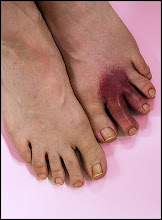Pentax K20D
First I tested the K20D against my K10D, using tungsten (hence constant) lighting, a tripod, DNG files, and the same lens swapped back and forth. Of course the file sizes were different. The K10D has a ten-megapixel sensor (3872 x 2592 pixels) and its DNG's are over 10 megabytes in size. The K20D has a 14.6-megapixel sensor (4672 x 3104) with 23+ megabyte DNG's. Assuming everything else is equal, you get a 20.6% linear advantage by moving from the K10D to the K20D – at 240 pixels per inch, my minimum for printing, the native document size of the K10D is 10.8" x 16.13" while that of the K20D is 12.93" x 19.47".
The K20D's ISO settings range from 200 to 3200. I compared the two cameras at 200-1600, using various ways to compensate for the variance in pixel density. It's easy to make this story short, since there weren't any striking differences. I feel that the K10D shows a bit less noise at ISO 1600, but it's hard to tell. And as you'd expect, if you down-res the K20D's images or up-res the K10D's, the sensor with more pixels has an advantage in resolution.
This morning I tried the K20D against my Canon 20D. The Canon has an eight-megapixel sensor (3504 x 2336 pixels) and 8+ megabyte raw files (in Canon's CR2 format). Its native doc size @ 240ppi is 9.733" x 14.6". Its sensor is a bit smaller than the Pentax/Samsung APS-C, with an adjustment factor of 1.6X as opposed to 1.5X. The best I could do to allow for this difference was to use a 70mm lens on the Pentax and a 60mm on the Canon, and to move the Canon physically closer to the scene I was photographing.
In this case the differences were obvious. I let both cameras set focus and exposure with the aperture at f/8. The Canon's images were always about one EV lighter. That's a known feature of Canon DSLR's, at least according to reviewers. I don't think the Pentax images were too dark, but I'll admit I haven't pursued this angle.
Another difference, less striking but still obvious, was noise. The Canon shows less noise at all sensitivity settings. Again that's in keeping with Canon's reputation. I'm not disappointed in the Pentax (especially considering its pixel density), and I'm very pleased with the Canon.
Then there's resolution. Of course the Pentax provides a bit more detail in the images. That said, the Canon's performance was very good, and this Canon is two generations behind their 40D. Impressive as ever.
And finally there are the imponderables, nuances I have trouble describing. In earlier posts to this blog I've babbled on about a certain snappiness and luminosity in Pentax images. I value that look very much, especially for B&W. I don't know whether to give the credit to their lenses (I use only primes), the way they've tuned their sensor and processor, or some combination of ingredients. Whatever it is, the K20D and the K10D both have it. That doesn't necessarily mean you'd like it (whatever It is) yourself. It's certainly easier to get a good standard image from the Canon with minimal work in Photoshop. Canon delivers a slick, smooth look that's just the ticket for most purposes. Yet I value the Pentax look myself.
Labels: Pentax K20D Review


Links to this post:
Create a Link
<< Home